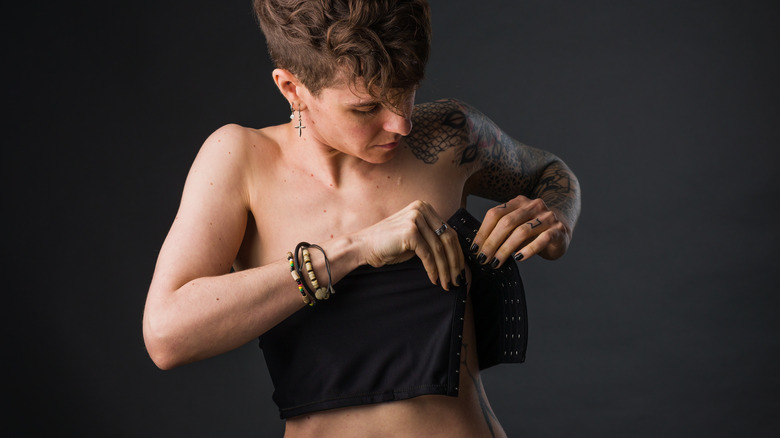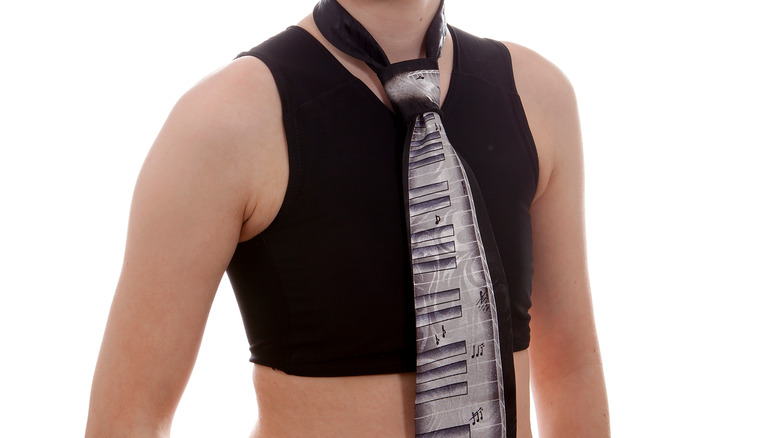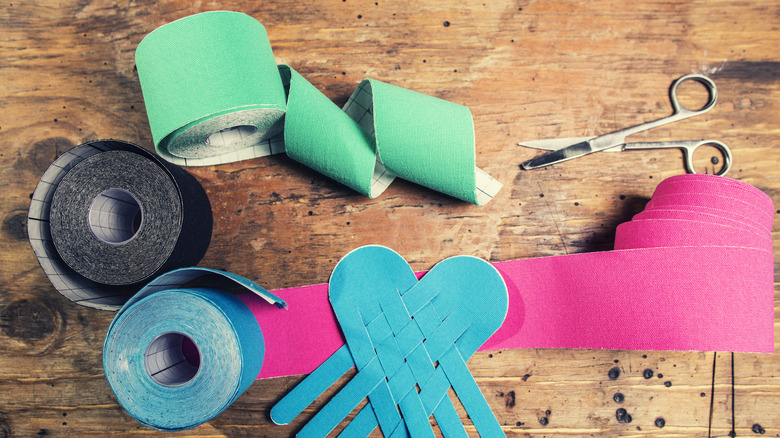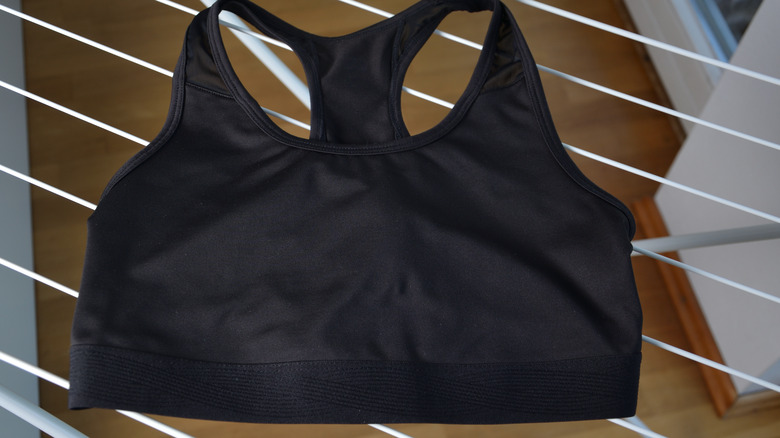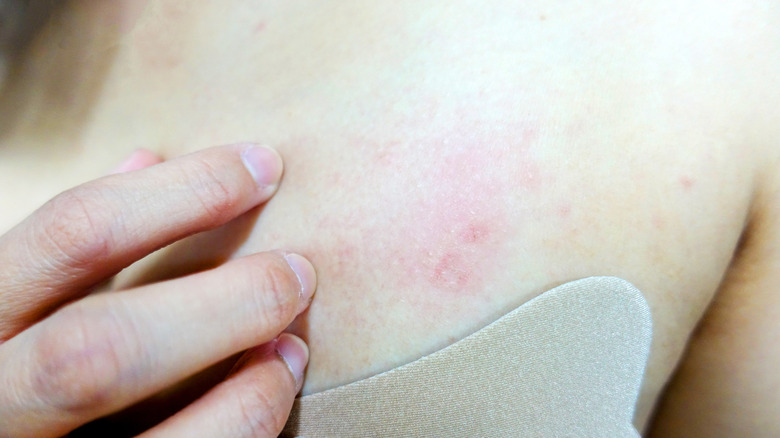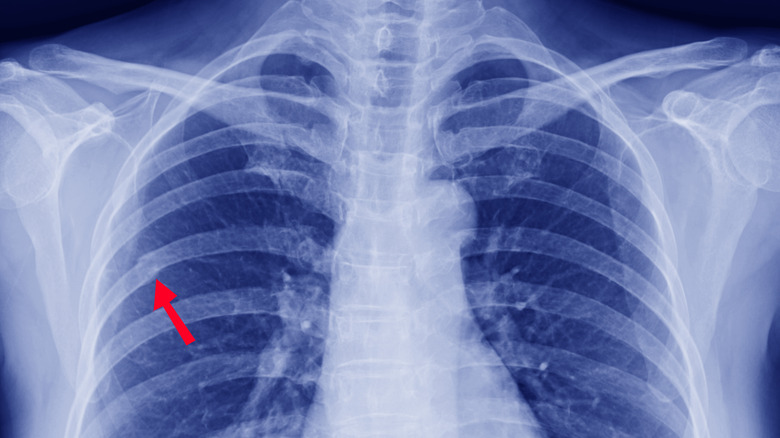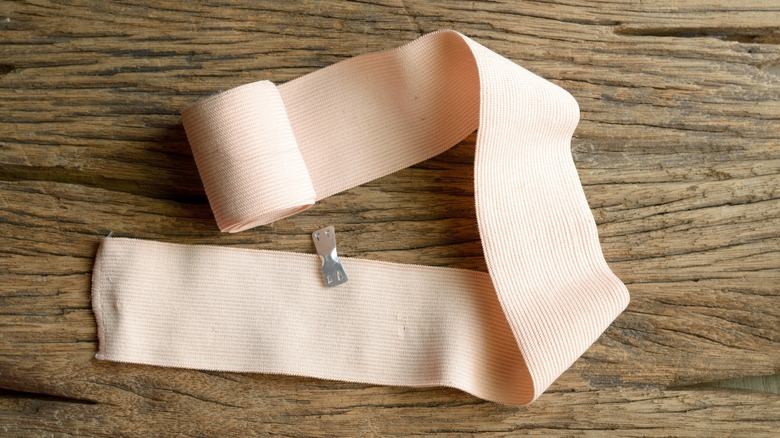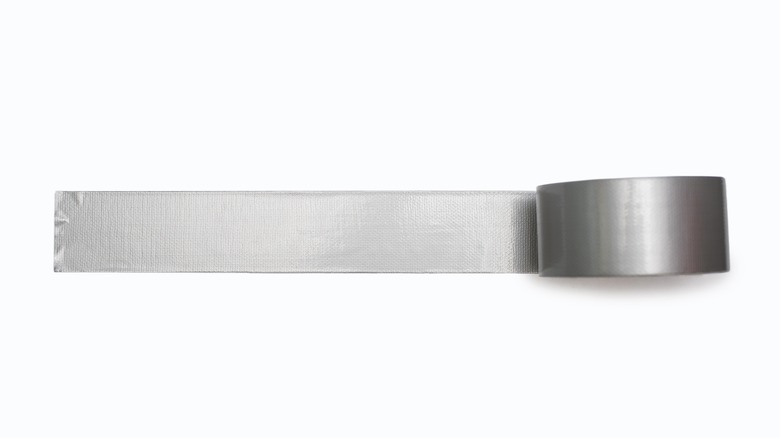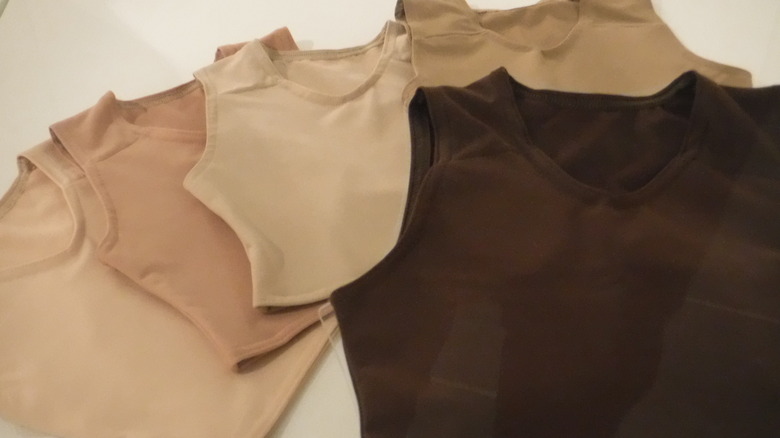What Is Chest Binding And What Are The Different Ways To Bind?
Chest binding is flattening breast tissue to give the chest a more masculine appearance. According to a paper on the practice published in "Culture, Health & Sexuality," chest binding is often done by trans men, transmasculine people, non-binary people, and gender non-conforming people who were assigned female at birth.
However, trans, non-binary, and gender non-conforming people are not the only ones who practice chest binding. Per Cosplay.com, chest binding is common among people who dress up as male characters from TV shows, movies, and comic books for conventions or gatherings, known as cosplayers. Some queer women also practice chest binding (via Autostraddle).
Chest binding can be done in several different ways, some of which are safe, some of which aren't. The most common way people practice chest binding is by wearing special compression garments called binders. Another common method is using TransTape, a special tape specifically designed for use on the skin. Other safe methods of chest binding include wearing compression sports bras, athletic compression clothing, and layering clothing to conceal the appearance of the chest.
There are risks involved with all chest binding, but when done correctly, with a safe method, these risks can be avoided. And the mental health benefits often far exceed the risks. Here's everything you need to know about safe chest binding.
Why people bind their chests
Most people who bind their chests are trans men, transmasculine, non-binary, or gender non-conforming people. According to a study of transgender and gender-diverse youth who practice chest binding, the majority of them bind because of a condition called chest dysphoria (via Journal of Adolescent Health). Trans men, transmasculine people, and some non-binary and gender non-conforming people assigned female at birth who experience chest dysphoria feel highly uncomfortable with their breasts because they give them a distinctly female appearance, which doesn't align with their gender. Essentially, chest binding is an effective treatment for chest dysphoria practiced by people who experience the condition.
The New York Times interviewed several people who practice chest binding about why they do it and the answers were startling but powerful. Several of the interviewees said that the appearance of their chests upset them so much that it caused severe depression, sometimes to the point of suicidal ideation. They all described intense joy and relief as a result of chest binding and stated that the practice significantly improved their mental health. A few even said binding saved their lives.
Cisgender women also chest bind sometimes. Women who cosplay – dress as characters from popular media for conventions and other gatherings — as male characters often chest bind to make their costumes more authentic (via cosplay.com). According to Autostraddle, some queer women also bind, either as part of their gender expression or for fashion purposes, usually to fit better in masculine clothing.
Binding with binder garments
Wearing a compression garment specifically designed for chest binding, called a binder, is one of the most common ways that people bind. According to Vice, binders are considered one of the safest ways to chest bind, when they're worn correctly.
Getting a binder from a reputable company is crucial. The Gender Confirmation Center recommends binders made by gc2b and Underworks. These brands are well-known and trusted by the trans community as well. Other highly recommended brands include Spectrum Outfitters in the UK, T-Kingdom in Taiwan, and UNTAG, a trans-owned binder company in the Netherlands. For those who can afford it, Shapeshifters makes custom binders, hand-sewn based on your measurements. And the company is run by a trans couple in Vermont.
For those who can't afford a binder at all, several organizations — including Point of Pride, AidenAizumi.com, Trans Essentials, and The Transitional Male – have programs to provide people with binders for free or for a small donation.
Because binders are very tight, and sometimes restrict movement a bit, it's important to wear them according to the guidelines given by experts. Do not size down when buying a binder. Binders should only be worn for eight hours max to give your body a break from the compression, and you should never sleep or work out in a binder. Often the material isn't very breathable, which can cause skin problems, especially when sweat is trapped under the binder.
Finding a binder that fits
Many people assume that buying a binder that's a bit too small for them will give their chest a flatter appearance. However, sizing down is actually really dangerous, per TransGuys. Since binders are designed to be very tight, sizing down can create too much compression, which can constrict your breathing and even damage your ribs. According to Vice, a small percentage of people who chest bind have fractured their ribs from wearing binders that were too tight or wearing their binders for too long.
So, it's essential to buy a binder that fits you well. Each binder company will have its own sizing guide that walks you through how to measure different parts of your body to find the best size for you. Most binder companies use measurements of your underbust – the circumference of your rib cage right under your breasts — and your bust — the circumference of the fullest part of your breasts. If you add these numbers together and divide by two to get the average measurement, this is usually the number you can use when looking at the sizing guide. Some companies, like gc2b, also require a measurement of your shoulders.
Comparing your measurements to the sizing guide of the particular binder brand you want to buy is the most important thing to do before buying a binder. Take the time to measure properly, and order the size that reflects your measurements to keep your body safe.
Binding with TransTape or KT Tape
People who can't afford binders, or can't wear them for various reasons, often bind with TransTape or KT Tape. The most common method involves using pieces of tape horizontally across the breast tissue and vertically over the breast tissue. One strip of tape is secured toward the center of the chest, on the edge of the breast tissue. Push the breast tissue to the side, then pull the tape horizontally across the tissue to flatten it out and secure the other end to the side of the body under the armpit. People with smaller chests often find that one horizontal piece of tape is enough, while people with larger chests often use two or more pieces.
Once the horizontal strip(s) is in place, another piece of tape is placed under the crease of the breast. While holding the breast tissue down, the strip is pulled up vertically and the other side is adhered over the top of the breast tissue, under the collarbone.
TransTape and KT Tape can both be worn for multiple days at a time, making them more convenient than a binder for many people. Some people get minor skin irritation or rashes from TransTape and/or KT Tape. This may be relieved by applying Phillips Milk of Magnesia to the skin before taping. It's important to put a small amount of tape on for 24 hours before doing a full application to see if it causes an allergic reaction.
Binding with compression or sports bras
For some people, binders and taping aren't an option. Luckily, as Hudson's FTM Resource Guide points out, there are several ways to practice chest binding safely without a binder or taping. Another method is wearing compression or sports bras. Those made with high percentages of a material called Lycra provide the most compression.
Unlike with binders, sizing down is perfectly fine with sports bras, as long as the band isn't so tight that it restricts your breathing or severely irritates your skin, per TomboyX. Some people also wear one, two, or even three compression or sports bras to get as much compression as possible. Though you can't wear more than one binder at a time, layering sports bras is okay as long as your movement isn't too restricted and it doesn't affect your breathing.
Some companies, like TomboyX, make compression bras and sports bras that are meant to be worn as binder alternatives. While these bras won't provide as much compression as a binder, many people find that compression and/or sports bras can give them the look they're going for. Though sports and compression bras are less likely to effectively bind people with large chests.
Another plus side to binding with compression and sports bras is that they're safe for long-term use and for all different activities. While you can't work out or sleep in a binder, you absolutely can in a compression or sports bra.
Using clothing to chest bind
People who want to make their chests appear more masculine but can't or don't want to use the more traditional methods often choose to disguise their chests with strategic style choices like layering their clothes. Point of Pride suggests wearing a tight t-shirt or tank top under a looser shirt with a top layer over the shirt. This could look like a tight muscle shirt under a loose t-shirt with a flannel or hoodie over the t-shirt.
Obviously, this isn't a great option for summer, but the idea can be adapted for summer as well. You could wear a compression sports bra with a tight tank and a loose t-shirt over that. The truth is that if you live in a place where the summers get hot, you're going to overheat while trying to hide your chest no matter what method you use, other than maybe open chest binding using TransTape or KT Tape.
Another layering option is wearing athletic compression shirts (via Fenway Health). These won't compress your chest nearly as well as a compression shirt made for binding, but they will get you a little flatter, especially if paired with a compression sports bra.
Though wearing a few layers will help disguise your chest, don't opt for too many layers. This leaves you looking bulky and bigger than you are. Also, be mindful of fit. A little baggy is perfect, but too baggy actually draws more attention to your body shape.
Binding with a large chest
For trans, non-binary, and gender non-conforming folks with large chests, achieving a masculine-looking chest can be extremely difficult, per LGBTQ and All. Obviously, they have more chest tissue to compress, but larger-chested folks also struggle to find binders, bras, and shirts that fit.
Folks with larger chests usually have to use binders to get the aesthetic they're going for. Compression or sports bras and layering clothing aren't enough to hide their chests. Unfortunately, many binder brands don't make binders that fit larger chests, and the brands that do often charge extra for binders that don't fall within their "regular" sizing. This creates a major financial barrier for many larger-chested trans folks.
Underworks binders go up to a 3X, and gc2b binders go up to a 5X. Remember to get your measurements and follow the size chart on the site, not the size you use for shirts or bras. For people who can afford it, a custom binder is the best option. Shapeshifters, a trans-owned binder company, hand sews all their binders based exactly on your measurements.
It's even more important to practice safe binder use when you have a larger chest, per Point of Pride. Never wear two binders at the same time or a binder over a sports bra. Doing so can hurt your lungs and ribs. You should also take longer, more frequent breaks from binding. Try to limit binding to six-ish hours, and never sleep with a binder on.
Binding as a plus size person
Binding as a plus-size person is even harder than binding with a large chest. J Aprileo, the writer behind the blog Comfy Fat, points out that plus-size trans, non-binary, and gender non-conforming folks who want to bind not only have to find garments that compress their chest, but also garments that fit the rest of their bodies. Before finding Shapeshifters' custom binders, Aprileo had given up. Even the binder brands that offered extended sizes didn't make garments that fit their body.
Tilke Wouters, a writer for Vice, had the same problem when looking for a binder. Many larger-chested people who aren't plus-sized opt for longer, tank-style binders to provide more compression. But Wouters found that this style rode up all the time because of their bigger body. And because of their proportions, binders that fit on Wouters' body often didn't provide enough compression for their chest.
Plus-size folks also have to be extra mindful of safe binding practices. Though it may be tempting to squeeze into a binder that's too small for your body, don't do it. You'll just end up in a lot of pain and probably injure yourself. Get your measurements and compare them to the size chart on gc2b, which has the largest range of sizes. If your measurements are bigger than their 5X, save the money for a custom binder. The wait will be excruciating, but having a binder that truly fits will be worth it.
Binding as a teen
Trans, non-binary, and gender non-conforming teens often face an obstacle that adults trying to affirm their gender don't — parents. According to the Transgender Teen Survival Guide, a blog run by a group of trans folks, many teens can't or just aren't ready to come out to their parents, which makes getting a binder really difficult.
Often, teens don't have access to their own money, credit cards, or debit cards, according to Lee, a Transgender Teen Survival Guide blogger. If they do, their parents are probably still monitoring their purchases. Even if they do have a way to purchase a binder, they still have to worry about the package that will show up at their house, which their parents will likely see.
Lee suggests a few ways teens can discreetly purchase or access binders. Instead of using a credit card to order, purchase a prepaid debit card or an Amazon gift card, and use these to make the purchase. They can also ask a friend to purchase a binder for them and pay them back. Most brands send their binders in nondescript packaging because they're aware that many people buying binders aren't out as trans, non-binary, or gender non-conforming to the people they live with.
The Transgender Teen Survival Guide adds that free binders are available via a number of binder donation programs and that using alternative methods of chest binding are great options for teens who can't yet access a binder.
Risks of chest binding
Though chest binding provides significant relief from gender dysphoria — the distress felt when a person's body doesn't match their gender — the practice does come with risks. One study published in "Transgender Health" found that nearly 89% of the study participants experienced at least one negative physical symptom as a result of chest binding (via National Library of Medicine). Another study published in the medical journal "Culture, Health & Sexuality" stated that about 97% of the transmasculine adults they surveyed reported negative physical symptoms related to chest binding.
Some of the physical symptoms were relatively minor, including rashes, acne, itchiness, and overheating. However, some were more serious including skin infections, chronic pain, shortness of breath, respiratory infections, headaches, and digestive issues. A small number of people experience severe physical symptoms such as rib fractures, changes to the curvature of the spine, issues with the shoulder joint, and/or muscle wasting. Skin problems and chronic pain, especially in the back and shoulders, were the most commonly reported issues.
The authors of both studies noted that though chest binding has multiple risks, most of these risks can be mitigated by proper binding practices. They also stressed that for many, the relief from gender dysphoria outweighs the physical risks, so they'll bind even if it's harmful. So, teaching people how to mitigate the risks of chest binding is crucial.
Minimizing the risks of chest binding
The best way to avoid the risks associated with chest binding is to follow the established guidelines set by medical professionals. Dr. Henry Ng told the Cleveland Clinic that the absolute best way to avoid negative physical symptoms when chest binding is to make sure that you don't bind all the time. Limit the number of hours you bind each day and take at least one day a week completely off from binding. He added that it's especially important not to wear a binder to bed as it can cause problems breathing while you're asleep.
WebMD suggests limiting chest binding to eight hours a day at the absolute maximum. When you get home, take off the binder, take several deep breaths, and stretch so your muscles can recover from being compressed for so long. If you need to wear your binder for more than eight hours in one day, excuse yourself, go somewhere private, and take off your binder for a bit. Even a little break can help.
It's also super important to keep your binder clean. Because binders are so tight, and often made of thick material, it can get pretty sweaty under there. Binders often trap sweat, which can lead to skin problems. If your binder isn't clean, that sweat can build up and create the perfect environment for bacteria and fungus, which can lead to skin infections. So, wash your binder thoroughly and often.
Never chest bind with elastic bandages
Some people who can't access garments specifically made for chest binding wrap their chests in elastic bandages to achieve a more masculine aesthetic (via Curve). Though this seems like a cheap alternative to binding garments, which can be expensive, chest binding with elastic bandages is actually very dangerous, according to the Stonewall Columbus Binder Program.
Elastic bandages have to be wrapped very tightly to give the appearance of a masculine chest. Additionally, they're designed to tighten as you move, which means that every time you breathe while your chest is wrapped in elastic bandages, they're actually getting tighter. The pressure this kind of compression puts on the ribs and lungs can cause significant damage. Think of rib fractures and even fluid buildup in the lungs.
Though it's tempting to bind with elastic bandages since they're readily available, cheap, and easy to pass off as not being used for chest binding if you're not out to family and friends, the benefits do not outweigh the risks.
Never chest bind with tape that's not made for skin
Many trans, non-binary, and gender non-conforming folks choose to bind their chests using TransTape or kinesiology tape, per TransGuy Supply. However, this doesn't mean that it's safe to bind with any kind of tape. TransTape and kinesiology tape are specifically designed for skin and to be worn for multiple days at a time. Chest binding with tape that isn't made for the skin is dangerous (Stonewall Columbus Binder Program).
Duct tape can significantly reduce range of motion, and since your lungs and ribs expand and contract with each breath, this limited range of motion can lead to breathing problems. Duct tape is also awful for your skin. It can cause rashes and even cut the skin while it's on. And taking it off is even worse. Since duct tape is so sticky, it can take multiple layers of skin with it when you pull it off. Not to mention the amount of chest hair you'll lose. And you worked hard for that chest hair!
Even though duct tape may seem like a cheaper alternative to other binding methods, it's way too risky.
Never wear two binders at once
Though it makes sense that wearing two binders would compress your chest more than one, Anchor Health says doing so can cause serious health problems. Wearing two binders obviously increases the amount of compression, which dangerously constricts your ribs, lungs, and chest. With that much constriction, you're at risk of damaging the bones, muscles, or even the lungs. The binders may also pinch and cut into the skin from being too tight. LGBTQ and All adds that even wearing a sports bra under a binder can lead to the same kinds of health issues.
Larger-chested and plus-size folks who have trouble hiding their chests are often the ones who opt to wear multiple binders at the same time or a binder over a sports bra. They may feel like this is the only way to achieve a masculine-looking chest. Even if this is true, doubling up on chest compression can be life-threatening.
